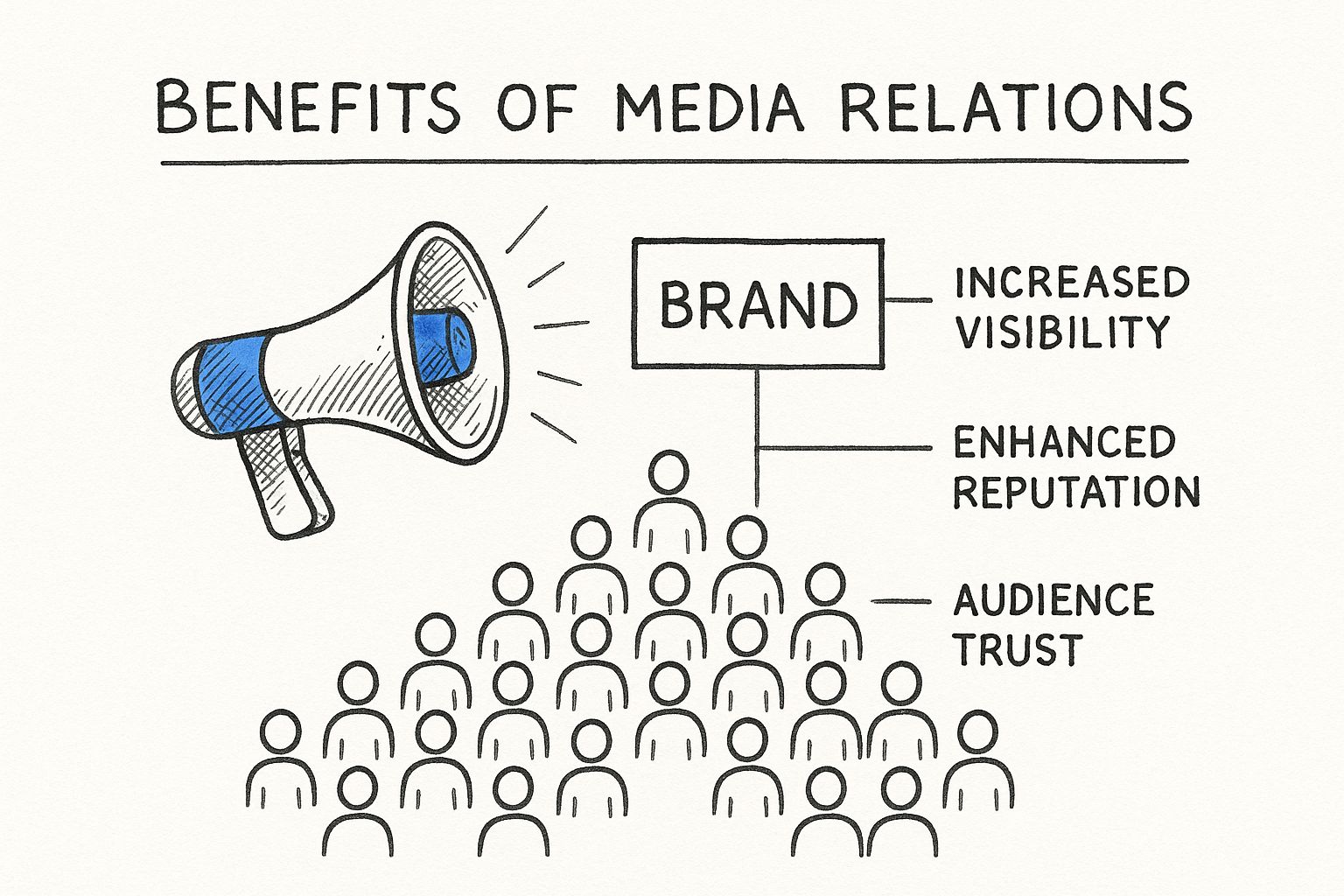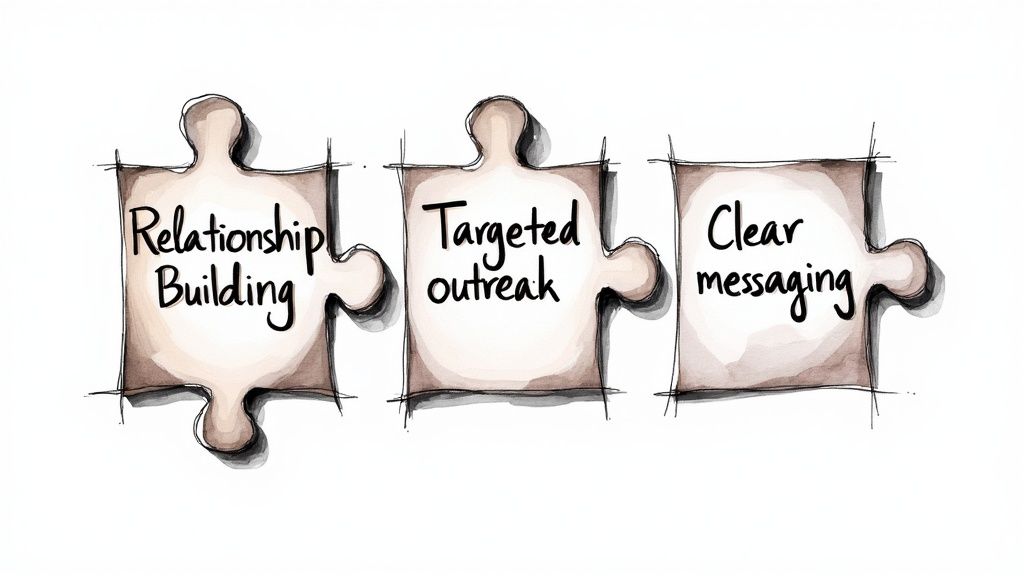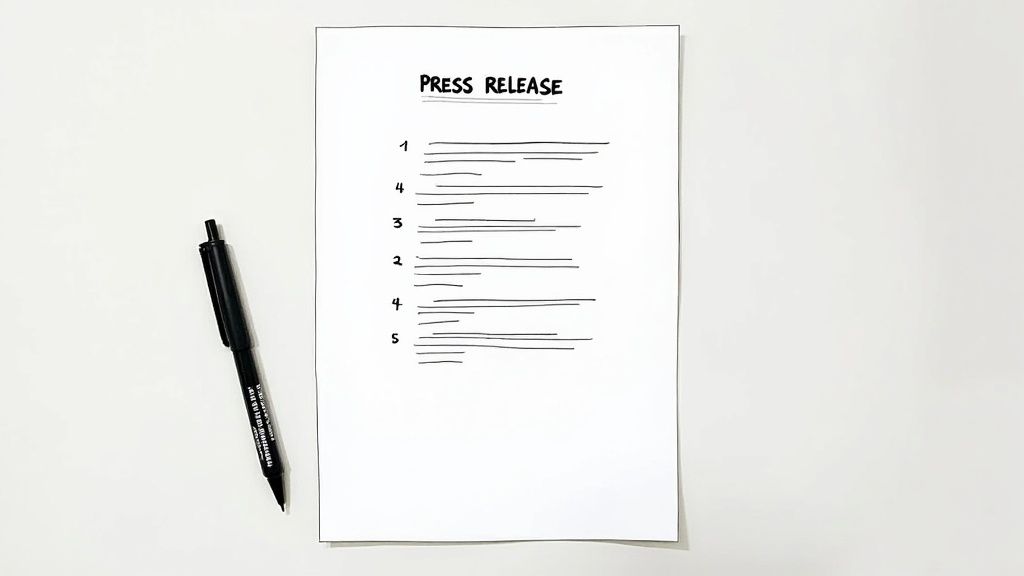What is Media Relations? Key Strategies to Boost Your Brand
October 4, 2025

Think of media relations as the art of building genuine connections with the people who tell stories for a living—journalists, editors, bloggers, and influencers. It’s all about earning your brand a spot in the limelight, not paying for it.
This is what we in the industry call earned media, and it’s a world away from a flashy ad campaign.
Understanding Media Relations and Its Core Value
At its core, media relations is about authentic communication. It’s the bridge between what your company is doing and the media outlets that shape how the public sees the world.
Advertising is straightforward: you pay for space, and you control the message. Media relations, on the other hand, works by earning the trust and interest of a third party, like a well-respected tech blog or a national newspaper. A feature story in a major publication often feels more genuine and carries more weight with readers than a banner ad on the same page.
The goal isn't just a fleeting mention. It's about carefully shaping your company's narrative and establishing yourself as a go-to expert in your field. This happens through consistent, professional, and helpful conversations with your media contacts.
Key Components of Media Relations
A solid media relations strategy isn't just one thing; it's a few key practices working in harmony.
- Powerful Storytelling: This is about finding the newsworthy hook in what you're doing. It could be a fascinating piece of data you've uncovered, a major company milestone, or an expert opinion on a trending topic.
- Smart, Targeted Outreach: Forget mass emails. Real media relations involves identifying the right journalists who cover your industry and sending them a pitch that actually speaks to their interests and audience. One well-crafted, personal email is worth a hundred generic blasts.
- Genuine Relationship Building: This is the long game. It means nurturing connections with reporters built on trust and reliability. When you become a source they can count on, they'll come to you for comments and stories, turning a single press hit into a lasting professional relationship.
Media relations is your brand's most authentic megaphone. It builds a level of trust that paid advertising simply can't buy, turning your company's story into a trusted news item.
When you invest in this strategic approach, you're not just scrambling for attention when you have an announcement. You're building a network of people who are already listening. It’s a powerful, long-term investment in your brand's reputation.
Media Relations vs. Advertising At a Glance
It's easy to confuse earned media with paid advertising, but they operate on completely different principles and deliver very different results. This table breaks down the core distinctions.
| Attribute | Media Relations (Earned Media) | Advertising (Paid Media) |
|---|---|---|
| Credibility | High—content is vetted by a trusted third party (the journalist/outlet). | Low—audiences know the brand is paying to promote itself. |
| Control | Low—the journalist ultimately controls the final story and angle. | High—you have complete control over the message, design, and placement. |
| Cost | Low financial cost, but high investment in time, strategy, and effort. | High financial cost—you pay for the ad space or airtime directly. |
| Longevity | High—a news story can live online indefinitely and build long-term SEO value. | Low—the campaign stops as soon as you stop paying for it. |
| Audience Reception | Generally viewed as authentic and informative news. | Often met with skepticism or ignored (ad blindness). |
While both have their place in a marketing strategy, the credibility and authority built through media relations offer a unique and powerful advantage that money alone can't secure.
The Pillars of a Powerful Media Relations Strategy
A great media relations program isn't just one thing; it's a system built on four key pillars. When you get each one right, you stop just blasting out emails and start strategically building your brand's authority and landing coverage that actually moves the needle. Together, they create a reliable process for getting noticed.
It all starts with a compelling story. This is your foundation. Journalists get buried under hundreds of pitches a day, so your angle has to be genuinely newsworthy. That means looking at your business and finding what’s truly unique—maybe it's some surprising data you've uncovered, a genuine industry-first, or just a human story that resonates.
Think of it like this: your brand has a story to tell, and media relations is the megaphone that gets it to the people who need to hear it.

Without that megaphone, even the most incredible stories get lost in the noise. The right strategy ensures your message is heard loud and clear.
From Story to Relationship
Once you’ve nailed your story, the next pillar is identifying the right media contacts. A targeted approach will always beat a shotgun blast. Taking the time to find journalists who actually cover your specific corner of the world shows you've done your homework and respect their work. It also massively boosts your odds of getting a response.
With the right person in your sights, it's time to perfect your outreach. This is about more than just a catchy subject line. Personalization is everything. Mention a recent article they wrote or explain why your story is a perfect fit for their beat. Get straight to the point: what’s in it for them and their readers? For a deep dive, our guide on pitching to media has templates and tips to help you craft the perfect message.
The final pillar is the one that really pays off in the long run: nurturing relationships. Media relations is a marathon, not a sprint. Follow up without being a pest, offer to be a go-to source for future stories, and engage with their work online. This is how you turn a one-off mention into a lasting connection with a professional who sees you as a credible expert.
Why Media Relations Is Your Secret Growth Engine

Good media relations is about more than just a quick headline. Think of it as a powerful engine for real, sustainable business growth. When a journalist or a respected publication covers your story, it’s not an ad—it’s a vote of confidence. That third-party endorsement is something money just can't buy, and it builds immediate trust with an audience that’s grown tired of sales pitches.
This kind of earned credibility isn't just a "nice to have." It becomes a real asset that gives you a serious leg up on the competition.
From Press Hits to Profit
Media coverage isn't just about making your brand look good; it's a direct path to finding new customers. A single feature in the right trade journal or a mention on a popular blog can put your brand in front of thousands of potential buyers who are already looking for what you offer. This is how you drive high-quality traffic to your website—people who are far more likely to convert than someone who stumbled across an ad.
And there’s a technical benefit, too. Almost every piece of online coverage comes with a backlink. When a high-authority site links to yours, it’s a huge signal to search engines like Google that you’re a credible source. This boost helps you climb the rankings for your most important keywords, creating a steady stream of organic traffic long after the article is published.
A smart media relations strategy is a clear investment in your bottom line. It's a deliberate effort to build your reputation, generate qualified leads, and strengthen your online presence—all of which fuel long-term, sustainable growth.
It all creates a powerful feedback loop that turns media mentions into measurable results:
- Builds Credibility: Earned media makes people trust you.
- Finds Your Audience: You connect with the right new customers.
- Boosts Your SEO: High-quality backlinks improve your search rankings.
- Drives New Leads: More relevant traffic means more potential business.
Tackling the Toughest Challenges in Modern Media Relations
Let's be blunt: getting media coverage today is harder than it's ever been. If you want to build a winning strategy, you first have to understand what you're up against. The old media world of just newspapers and TV stations is long gone. What we have now is a chaotic, splintered environment where journalists are overworked, underfunded, and drowning in information.
This pressure cooker has a direct impact on how you need to approach them. Newsrooms keep getting smaller, yet the number of people pitching stories has skyrocketed. The result? A massive bottleneck. Journalists simply don't have the bandwidth to dig through a mountain of emails hoping to find a hidden gem. They need a great story, served up on a silver platter.
The data backs this up. A recent report confirmed that while email is still the go-to for 96% of journalists, a staggering 47% say the pitches they get are rarely relevant to what they actually cover. This constant flood of bad pitches is why your emails get ignored and why it feels impossible to break through. Interestingly, that same study shows LinkedIn has now surpassed X (formerly Twitter) as the top social network for journalists, signaling a move toward more professional, curated interactions.
The Overwhelmed Newsroom
Picture a modern journalist's inbox. It's not just full; it's a warzone. Hundreds of pitches land every single day, and yours has just a few seconds to grab their attention. This is precisely why that generic, mass-blasted press release almost always fails. It doesn't just get deleted—it can actually hurt your credibility with that person forever.
In this environment, your pitch can't just be about you. It has to be a solution for the journalist. It needs to be a well-researched, perfectly targeted story that fits their beat so well they’d feel foolish to pass it up.
Getting this right changes everything. It's not a numbers game of sending more emails; it’s about sending much, much smarter ones. This high-stakes environment also shows why having solid crisis communication best practices is non-negotiable, because one wrong move can spiral out of control fast. Every single email is a chance to either build a valuable relationship or burn a bridge for good.
How to Adapt Your Strategy and Win

Given the immense pressure journalists are under today, your media relations strategy has to be nimble and genuinely helpful. The old "spray and pray" method of blasting out press releases is completely finished. Winning now means acting like a true partner to the media, not just another person asking for a favor.
The key is to give them high-value, ready-to-use content that makes their jobs easier. This isn't just a nice idea; it’s a response to the tough economic climate in journalism. One recent analysis found that news organizations are grappling with profit margins as low as 5%, forcing them to do more with less.
This is your opening. When you offer well-researched data, expert quotes, or sharp visuals, you’re not just pitching your story—you're solving a resource problem for them. It’s a classic win-win. You can discover more insights about media relations strategies for 2024 to get ahead.
Embrace a Multi-Channel Mindset
Putting all your eggs in one basket is a recipe for failure. While search engines are still important for news discovery, the game is changing fast with the rise of AI and shifting social media trends. The once-reliable traffic from platforms like Facebook and X has dwindled, meaning savvy PR pros have to get creative and find new ways to connect.
It’s all about building a presence where your audience and the journalists you want to reach are actually spending their time.
- Owned Media: Don't wait for permission. Use your company blog, newsletter, or podcast to publish original research and position yourself as an authority.
- Targeted Social Engagement: Forget generic posting. Focus on building real connections on platforms like LinkedIn, where you can join and lead meaningful industry conversations.
- Strategic Partnerships: Team up with non-competing brands or influencers. You can cross-promote content and tap into new, highly relevant audiences that would have been harder to reach alone.
The modern playbook for what is media relations involves creating your own gravity. By becoming a primary source of valuable information, you make journalists want to come to you, flipping the traditional dynamic on its head.
Measuring Media Relations Success That Matters
So, how do you actually prove your media relations strategy is working? It's a question every PR pro faces. In the past, you might have pointed to a stack of press clippings, but simply counting brand mentions doesn't tell the whole story. Those are just vanity metrics.
Real success is all about impact—how that media coverage moves the needle on your actual business goals, from shaping how people see your brand to driving real revenue. This means we have to dig a little deeper than clip counts and focus on the quality and influence of the media you've earned.
Key Performance Indicators That Drive Value
To show the true value of your work, you need to track a few powerful KPIs. These metrics paint a much richer picture of what your media relations is accomplishing and how it's helping the company grow.
Share of Voice (SOV): Think of this as your slice of the pie. It measures how much of the conversation in your industry features your brand compared to your competitors. When your SOV is growing, you know you're capturing more attention and becoming a bigger player.
Sentiment Analysis: It’s not just about getting mentioned; it’s about how you’re mentioned. Was the coverage positive, negative, or just neutral? Understanding the tone is vital for keeping a finger on the pulse of public perception and brand health.
Message Pull-Through: Are journalists actually picking up on what you're putting down? This KPI tracks how well your core brand messages are making it into the final articles. It’s a great way to see if your story is truly hitting home.
Proving ROI means connecting earned media to marketing goals. When you can show that a feature in a major publication directly led to a spike in website traffic and new leads, you're speaking the language of business growth.
Tying PR to Business Impact
Ultimately, the goal is to draw a straight line from your PR efforts to tangible business outcomes. A great place to start is by tracking referral traffic in your web analytics. Which articles are sending qualified visitors to your site? This shows you which placements are actually driving interest.
Another powerful connection is the SEO benefit. High-quality backlinks from reputable news sites can significantly boost your website's domain authority, which is a direct win for your marketing team. For a deeper dive, check out our complete guide on public relations measurement.
Adopting this data-focused mindset is more important than ever. With global social media ad budgets climbing to an estimated $276.7 billion, the pressure to demonstrate the unique, organic value of earned media has never been higher.
A Few Common Questions About Media Relations
Getting into the nitty-gritty of media relations always brings up a few questions. Let's tackle some of the most common ones that pop up when people are first dipping their toes in.
What’s the Difference Between Public Relations and Media Relations?
This is probably the number one question people ask. The easiest way to think about it is that Public Relations (PR) is the whole pie—it’s every single thing a company does to manage its public image. That includes social media, company events, internal newsletters, crisis management, you name it.
Media relations, on the other hand, is just one important slice of that pie. It has a very specific job: to build relationships with journalists, reporters, bloggers, and producers to get your story told through their channels. This is what we call earned media, and it’s a powerful piece of the overall PR puzzle.
How Can a Small Business Get Started?
If you're a small business, the best way to start is to think small and sharp. Forget about trying to get on the cover of a national magazine right away. First, figure out what makes your business interesting. Do you have a unique founding story, some surprising data, or an expert opinion on a local issue?
Once you have your story, build a tight, targeted list of local journalists or bloggers who actually cover your specific industry or community. A quick, personal email explaining why your story would matter to their readers is all it takes to get the ball rolling. A few solid local connections will do more for you than a scattergun email blast to a hundred random reporters ever could.
A lot of people think the press release is dead. That’s not quite right. While sending out generic announcements to a massive list is useless, a well-crafted press release is still the best formal way to share big news, like a funding round or a major product launch. It gives reporters an official source to pull from.
Ready to get your story in front of the right journalists? PressBeat uses AI to connect your brand with media outlets, automating outreach and helping you earn high-impact coverage. Discover how it works at https://pressbeat.io.